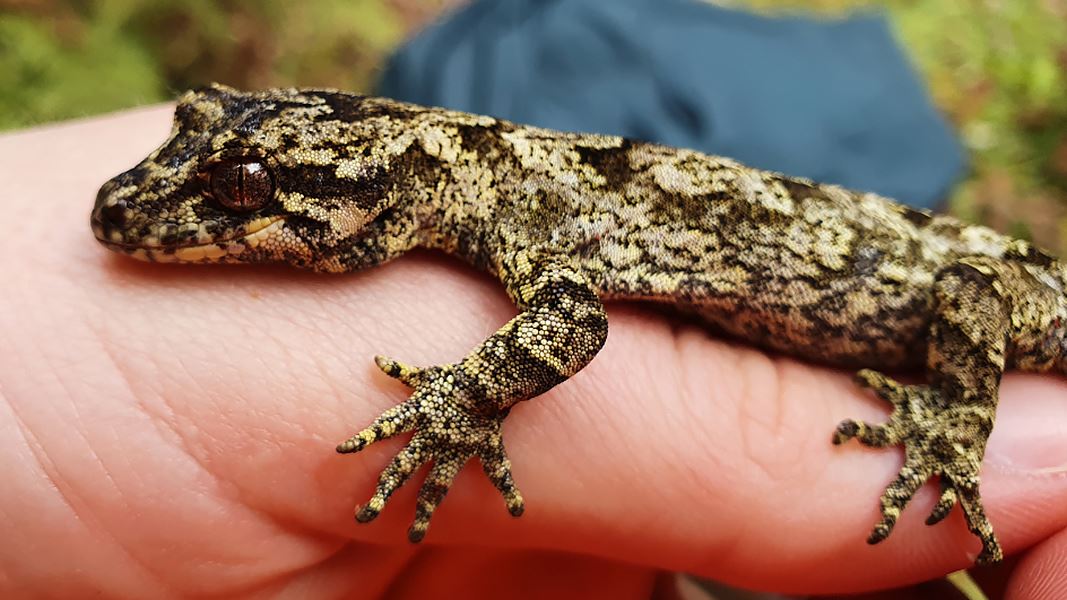List of data poor lizards
Awakopaka skink (Oligosoma awakopaka)
Conservation status: Nationally Critical
Arguably one of the most handsome skinks with flecked yellow and brown scales. A small population is known from northern Fiordland but extensive surveys have failed to find any new populations. As a result this species has been assigned a Threat Classification of Nationally Critical.
Further surveys for this species is planned.
Westport skink (Oligosoma aff. infrapunctatum "Westport")
Conservation status: Data deficient
A species found transported on a truck and probably far from its original location. We know so little about this species that it's impossible to do any targeted surveys.
Hokitika skink (Oligosoma aff. infrapunctatum ‘Hokitika’)
Conservation status: Nationally Critical
Originally known only from one museum specimen, and one live skink found during detailed surveys for this species. Unfortunately the site does not seem to have a viable populations.
The preferred habitat is unknown but a small population was found in 2020 near Westport. Two additional populations were found in 2021. Unfortunately those populations were all inundated during the 2021 Westport floods and its not yet known if they have survived.
Further surveys are planned.
Sabine gecko (Woodworthia new sp.)
Conservation status: Data deficient
This species was found during surveys targeting a different species in 2021. So far it is only known from one individual, but further surveys are planned. It's considered data deficient.
Kahurangi skink (Oligosoma new sp)
Conservation status: Nationally Critical
This species was discovered in an alpine area in Kahurangi National Park. Further surveys are planned to understand its distribution and abundance. This species has a tail that is 1 and a half times longer than its body length.
Okarito gecko (Mokopiriakau "Okarito")
Conservation status: Nationally Vulnerable
Previously known only from a few scattered locations near Okarito, this species has now been found further north and its range has been extended. This species could be more widespread and further survey are planned.
This species is likely to be difficult to detect but research is underway to test a range of tools to see which is better for detecting them.
Okuru skink (Oligosoma "Okuru")
Conservation status: Data deficient
Known only from one animal. The habitat in the original location has been destroyed. Several surveys in similar nearby habitats have failed to detect any new populations.
Okarito skink (Oligosoma new sp.)
Conservation status: Data deficient
This species was discovered in 2021 and is still unnamed. Only a handful of individuals have been found. More surveys are planned, and these surveys aim to better understand their habitats, numbers and distribution.
Open Bay Island gecko (Mokopirirakau “Open Bay Islands”)
Conservation status: Nationally Critical
This Nationally Critical species was only known from Taumaka Islands off Haast but a small population was found in 2021 on the inland ranges of Haast.
The find in this alpine area suggests this species previously ranged from the coast to the alps and has probably disappeared in lowland areas due to the presence of highly abundant predator populations.
Mataura skink (Oligosoma new sp)
Conservation status: Data deficient
This species is only known from one individual, and nothing is known about it. Surveys for this species will be undertaken over the next few years.
Threats
Very little is known about any of these species, so it’s very difficult to predict the threats they're facing.
However, we know that all our lizards are declining because of predation from introduced predators. So we expect mice, hedgehogs and wasps to be a significant predator, but rats, mustelids, and cats will also be preying upon lizards.
Our work
Doing detailed surveys is the only way to find out more about data poor and data deficient species. This tells us more about the habitat requirements, population, range, and threats.
Targeted surveys for some species is possible, and is guided by the limited information we have about them. However we have so little information for other species that it's difficult to know where to do targeted surveys. In these cases we often rely on sightings from the public to guide future surveys.
You can help
Report all lizards sightings to the local DOC office. Any records of lizards are important and help build our understanding of lizard distribution. Significant discoveries are often made by following up observations from locals.
In particular, we need records from Buller, Westland, and forests.
Also any alpine environment – report an alpine lizard.
